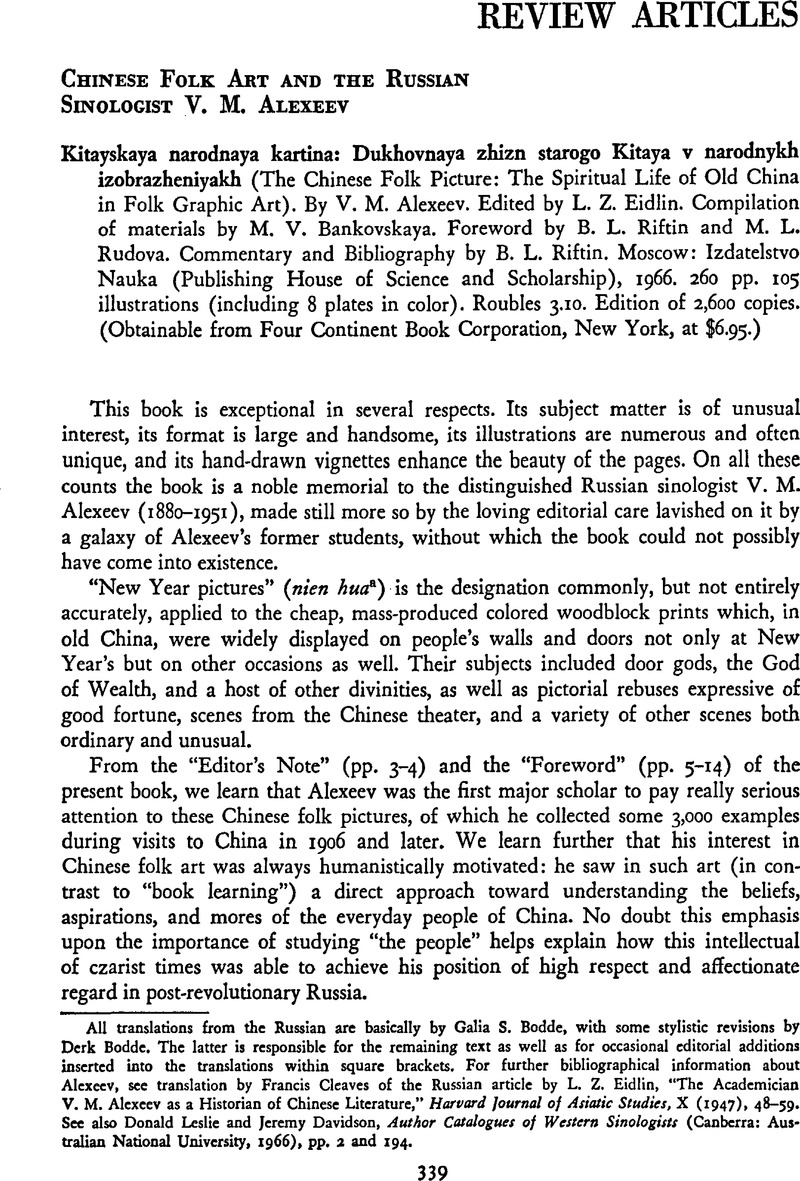No CrossRef data available.
Published online by Cambridge University Press: 23 March 2011

All translations from the Russian are basically by Galia S. Bodde, with some stylistic revisions by Derk Bodde. The latter is responsible for the remaining text as well as for occasional editorial additions inserted into the translations within square brackets. For further bibliographical information about Alexeev, see translation by Francis Cleaves of the Russian article by L. Z. Eidlin, “The Academician V. M. Alexeev as a Historian of Chinese Literature,” Harvard Journal of Asiatic Studies, X (1947), 48–59. See also Donald Leslie and Jeremy Davidson, Author Catalogues of Western Sinologists (Canberra: Australian National University, 1966), pp. 2 and 194.
1 Much of the collection consisted of pictures having a dark blue background—known in Chinese as ch'ing ti hua o—which so far as we know are unmentioned even by Chinese scholars, and do not appear in later collections. This collection still remains in the ethnographic museum of the University of Kazan.
2 Rovinsky, D., Russkiye narodnye kartinki (Russian Folk Pictures), I (St. Petersburg, 1900), 63Google Scholar.
3 See V. M. Alexeev, Kitayskaya narodnaya kartina to storony eyo soderzhaniya … (The Chinese Folk Picture from the Point of View of Its Content …), p. 40. [Apparently this is one of Alexeev's unpublished studies, since no place or date of publication is indicated.]
4 Manuscript in the files of N. M. Alexeeva [Mme. Alexeev].
5 V. M. Alexeev, V. Starom Kitaye (In Old China), p. 75. [This again is apparently an unpublished manuscript.]
6 See below, p. 172. [The reference is to note 1 of Alexeev's article, ‘The Immortal Pair …,” reprinted in this volume.]
7 See below, p. 21. [The reference is to the previously unpublished article, “The Chinese Folk Picture and Views Concerning Its Further Study.”]
8 For example, among his lectures and discussions on the Chinese theater (especially those made in connection with Mei Lan-fang's tour of the U.S.S.R. in 1935), Alexeev spoke in Leningrad in the Pushkin State Drama Theatre, in the Academy of Arts, in the Institute of Theatre and Music, at the Union of Artists, in the Geographical Society, and in many other places (including even a sanatorium at Tshaltubo where he once stayed).
9 Alexéiev, V. M., The Chinese Cods of Wealth (London, 1928)Google Scholar.
10 See below, p. 55. [The reference is to the same unpublished article of 1935 cited in note 7.]
11 See below, pp. 54–55 [again the same reference as in notes 7 and 10].
12 See I. P. Garanin, “Kitaysky antikhristiansky lubok XIX v.” (Chinese Anti-Christian Folk Pictures of the 19th Century), Ezhegodnik Muzeya Istorii Religii i Ateizma (Annual of the Museum of the History of Religion and of Atheism), IV (1960), 403–26. The writers of the “Foreword” make no mention of the fact that seven pictures from the same anti-Christian series have been reproduced, with translation of their texts, in Cohen, Paul A., China and Christianity, the Missionary Movement and the Growth of Chinese Antijoreignism, 1860–1870 (Cambridge, Mass.: Harvard University Press, 1963)Google Scholar. Of these seven pictures, the first and fifth are the same as illustrations 72–73 in Alexeev; the others differ from Alexeev's remaining nos. 71 and 74.